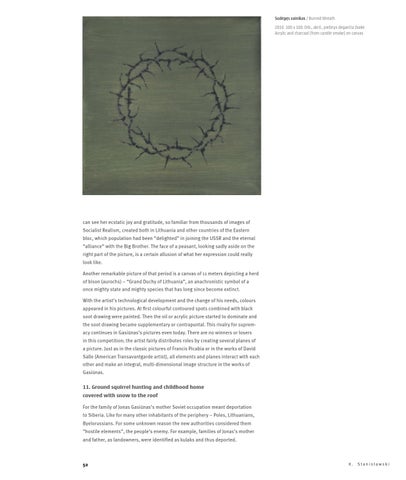Sudegęs vainikas / Burned Wreath 2010. 100 x 100. Drb., akril., piešinys degančia žvake Acrylic and charcoal (from candle smoke) on canvas
can see her ecstatic joy and gratitude, so familiar from thousands of images of Socialist Realism, created both in Lithuania and other countries of the Eastern bloc, which population had been “delighted” in joining the USSR and the eternal “alliance” with the Big Brother. The face of a peasant, looking sadly aside on the right part of the picture, is a certain allusion of what her expression could really look like. Another remarkable picture of that period is a canvas of 11 meters depicting a herd of bison (aurochs) – “Grand Duchy of Lithuania”, an anachronistic symbol of a once mighty state and mighty species that has long since become extinct. With the artist’s technological development and the change of his needs, colours appeared in his pictures. At first colourful contoured spots combined with black soot drawing were painted. Then the oil or acrylic picture started to dominate and the soot drawing became supplementary or contrapuntal. This rivalry for supremacy continues in Gasiūnas’s pictures even today. There are no winners or losers in this competition; the artist fairly distributes roles by creating several planes of a picture. Just as in the classic pictures of Francis Picabia or in the works of David Salle (American Transavantgarde artist), all elements and planes interact with each other and make an integral, multi-dimensional image structure in the works of Gasiūnas.
11. Ground squirrel hunting and childhood home covered with snow to the roof For the family of Jonas Gasiūnas’s mother Soviet occupation meant deportation to Siberia. Like for many other inhabitants of the periphery – Poles, Lithuanians, Byelorussians. For some unknown reason the new authorities considered them “hostile elements”, the people’s enemy. For example, families of Jonas’s mother and father, as landowners, were identified as kulaks and thus deported.
52
K.
Stanisławski
